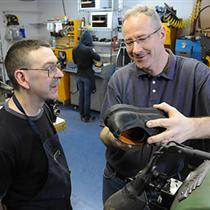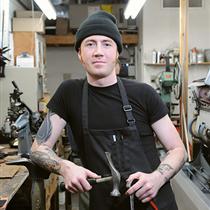Sole
survivors
The guardians of battered footwear, Vancouver's remaining shoe cobblers face high rents and a throwaway society
Vancouver
Courier
Writen
by Milton Kiang
Photos
by Dan Toulgoet
January 28, 2009
Kung
Ho, 62, owner of Robson Shoe Renu on 520 Robson
St., works in a space about 12 feet by 10 feet, no larger than
a prison cell, for eight hours a day (minus 10 to 15 minutes
for lunch), six days a week.
While Ho stitches soles
and hammers heels, he breathes in industrial fumes, stands for
most of the day, and contends with shoe polish smearing his
fingers and clothes. With his glasses perched at the tip of
his nose, Ho has an affable but direct disposition. When I ask
him about the future of the shoe cobbling trade, he replies,
"Young people nowadays would rather make fast money! They like
to have a comfortable desk job, like in IT or computers."
 Robson
Shoe Renu sits in the middle of a one-storey block of ground
floor shops, alongside a greasy spoon (S'il Vous Plait, open
for 23 years) and a men's barber (Waverly Barber, open for 22
years). The shop is nestled among high-rise towers with shiny
storefronts for businesses like Future Shop, Starbucks and Rogers
Wireless. With its pink and blue neon sign, painted wooden door
frame, and stacks of leather shoes leaning behind the foggy
storefront window, Robson Shoe Renu is reminiscent of a bygone
era.
Robson
Shoe Renu sits in the middle of a one-storey block of ground
floor shops, alongside a greasy spoon (S'il Vous Plait, open
for 23 years) and a men's barber (Waverly Barber, open for 22
years). The shop is nestled among high-rise towers with shiny
storefronts for businesses like Future Shop, Starbucks and Rogers
Wireless. With its pink and blue neon sign, painted wooden door
frame, and stacks of leather shoes leaning behind the foggy
storefront window, Robson Shoe Renu is reminiscent of a bygone
era.
According to Ho, who's
been repairing shoes for 32 years, six shoe cobblers used to
operate between the 1100- and 1200-block Robson Street during
the '70s. Today, Ho's is the only shoe repair shop on Robson
Street.
For anyone who's had to
stitch up a favourite pair of Fluevogs, or replace the soles
on her Prada pumps, the Vancouver shoe cobbler is a godsend:
a skilled craftsman capable of restoring a weathered ankle boot
to its former glory. But despite continued population growth,
the Vancouver shoe cobbler is a dying breed, a victim of the
city's sky-high rents, a consumer-oriented society obsessed
with all things new and globalization where it's cheaper to
buy a pair of mass-produced shoes than to pay for shoe repair
costs.
In the early '50s, 300
shoe cobblers operated within the city. Now there are less than
70. Shoe finders, the companies who supplied shoe cobblers with
leather hides, soles, heels and laces, once ran a brisk business.
In 1963, eight shoe finders did business throughout the Lower
Mainland, now there is only one: La Belle Supply, running since
1948, serves Vancouver and the western Canadian market. "I'd
say we're a mature business," says Lorne La Belle, 52, the second-generation
owner of La Belle Supply in Burnaby.
The Vancouver shoe cobbler
flourished in an era when a different set of values prevailed.
"In the old days, a person had just two pairs of decent shoes,"
says Ron Smith, 49, the second-generation owner of Russell's
Boot and Shoe Repair at 2589 West 16th Ave. "But they were fitted
properly for your feet, and you had them repaired whenever it
was required. I've had my work boots rebuilt 16 times!"
During the Second World
War, when leather supplies were scarce, shoe stores turned away
children because they couldn't stock enough inventory. People
relied on cobblers to extend the lives of their shoes. Cobblers
were so busy that at one point they had to close their shops
in the middle of the week just to catch up on work. Even into
the mid-'50s, cobblers were so overworked that they collectively
petitioned for a five-day work week. When the Vancouver Master
Shoemaker's Association voted to raise shoe repair prices by
25 per cent in 1947, the announcement made the daily papers.
 "There
used to be four cobblers on every street corner, and two in-between,"
jokes Paul Kardynal, 84, owner of Kardynal Shoes on MacDonald
Street and West 24th Avenue. Opened in 1949, Kardynal's shop
is the oldest shoe repair business in town. Kardynal's father
was also a cobbler. Having just served in the Canadian Navy
as an able seaman, Kardynal opened his shop on MacDonald Street,
an area, according to Kardynal, "resembling swampland," with
hardly anyone in the vicinity except young veterans who wanted
to be closer to the University of British Columbia.
"There
used to be four cobblers on every street corner, and two in-between,"
jokes Paul Kardynal, 84, owner of Kardynal Shoes on MacDonald
Street and West 24th Avenue. Opened in 1949, Kardynal's shop
is the oldest shoe repair business in town. Kardynal's father
was also a cobbler. Having just served in the Canadian Navy
as an able seaman, Kardynal opened his shop on MacDonald Street,
an area, according to Kardynal, "resembling swampland," with
hardly anyone in the vicinity except young veterans who wanted
to be closer to the University of British Columbia.
It was a time when thrift
and modest spending habits ruled the day. Kardynal recalls a
customer who once asked how much it would cost to nail a blaike
(a thin metal toe piece) beneath the tips of her leather pumps.
Fifteen cents, Kardynal replied. The customer balked, saying
she'd rather go to Victoria Drive to have them done for a dime.
Smith has a similar story.
He recalls his father's former location on West Fourth Avenue
and Alma Street. In the '50s, there were three other shoe cobblers
on that corner. Smith's father would frequently get customers
who'd "comparison shop," trying to get shoe cobblers to underbid
one another. "Dad would get so choked, he finally decided to
move his store," says Smith, whose shop now sits at West 16th
Avenue and MacDonald Street.
In Aimee Liu's 1986 book
Shoe Time, the author notes that in the 18th century, "The village
shoemaker was considered a craftsman, and the profession had
become so attractive that apprentices worked seven years just
to become full-fledged shoemakers."
Up until the late-'80s,
Vancouver Community College offered a one-year shoe repair program,
which provided students with course books and shop floor experience.
La Belle Supply provided a lot of the materials used in the
program. Classes went on for six hours a day, five days a week.
For hundreds of Vancouverites, shoe cobbling represented an
enduring craft and promising livelihood. Today, with no shoe
repair courses available, it's a craft that's handed down from
shoe cobbler to apprentice.
Bob Wong, 80, of Bob's
Shoe Repair on Oak Street and West 16th Avenue, graduated from
the shoe repair program in 1957. Wong has an easy smile, and
stands alert behind his counter, ready to greet customers walking
through the door. His diploma hangs on top of the doorway inside
his shop. When Wong opened his shop in 1959, he had no idea
the business would run for half a century. It's now Vancouver's
second oldest shoe repair business after Kardynal's shop.
Initially, after setting
up his shop, Wong found business slow. He and his wife lived
in the back of their shop, in a 400-square-foot space with no
hot water, proper ventilation or working stove. To make ends
meet, Wong worked on weekends for $64 a month as a delivery
boy for a Chinese takeaway.
By the late '60s, business
improved, and Wong no longer needed to work part-time. He bought
a home in South Vancouver and raised three children. Over the
years, Wong trained apprentices who've gone off to establish
their own shoe repair stores. Of the four apprentices who've
become their own bosses, only one business exists today--Henry's
Shoe Repairs on Main Street and East 48th Avenue.
"You know, I don't have
much education, but I feel lucky to make a decent living in
all these years," says Wong. It was luck plus hard work. Throughout
the last half-century, shops on his block have come and gone
including another shoe repair store. Wong's is the longest standing
business on the block.
On New Year's Eve, Wong
is busy catching up on the backlog of work from the holiday
season. A customer walks in, plunks a pair of shoes on the counter,
and asks, "How was your Christmas, Bob? How are your grandkids?"
Wong greets his regular customer as if they were long lost friends.
He tells her the grandkids are just great. Wong takes her pumps
(which will require new heels) and asks her to come back after
New Year's Day.
"I know a lot of my old
customers," says Wong. "I don't even need to give them a receipt.
They trust me." The trust between shop owner and customer--the
attention one receives from small businesses like Wong's--seems
to be on a wane as big box stores and multinational franchises
push out the city's mom-and-pop stores.
Vancouver Magazine writer
Daniel Wood describes a visit to the cobblers as getting "a
sense of community being in these smaller shops." Wood, a longtime
customer of David's Leather Shoe Repair in Kits, says, "A couple
times a year, I'll go into David's shop, he and his wife will
greet me, they'll ask me how my writing is coming along. They
know your name, they know who you are. It's what living in a
community is all about."
David Leung, 57, has run
David's Leather Shoe Repair for the last 32 years. Like Wong,
Leung graduated from the Vancouver shoe repair program, completing
his diploma in 1977. But unlike Wong, Leung's landlord hasn't
been as kind. In 2005, Leung's landlord raised the rent from
$1,450 to $5,000, making it impossible for Leung to do business
on the block. Leung was forced to leave his West Fourth Avenue
and Arbutus Street location and move further west. Leung is
now at West Fourth Avenue and MacDonald Street, but his revenue
has decreased by half due to less customer foot traffic and
having to build up a new clientele.
"Paying the rent is the
most difficult part," says Leung's wife, Eva. "It's killing
the business. Even if you worked 24 hours a day, you'd still
have a hard time making ends meet." At Leung's old location
stands a franchised watch store, Watch IT! Sitting on one side
is a Footlocker, on the other a Telus mobility store.
 Over
in Fairview Slopes, Ronald Nijdam, 50, owner of The Quick Cobbler
on West Second Avenue and Yukon Street, operates a different
kind of shoe repair shop, one more in tune for a younger, more
fashionable crowd.
Over
in Fairview Slopes, Ronald Nijdam, 50, owner of The Quick Cobbler
on West Second Avenue and Yukon Street, operates a different
kind of shoe repair shop, one more in tune for a younger, more
fashionable crowd.
Nijdam's storefront consists
of floor-to-ceiling glass; the interior is bright and spacious,
carpets cover the floors, and awards from the Shoe Service Industry
Council and Shoe Service Institute of America adorn the walls.
A customer who, on a recent Saturday afternoon, took in his
four-year-old Blundstone boots to have the soles replaced (costing
$70), says the store was "buzzing with customers."
With his short grey hair,
professorial glasses and polished demeanor, Nijdam, a third-generation
shoe cobbler from Holland, appears more like a management consultant
than a shoe repair man. Nijdam has moved locations twice in
the 21 years he's been in business, but with each move he's
acquired more shop space. His first shop occupied 400 square
feet, his second 1,000 square feet, and his current location
2,400 square feet. Njidam's business has grown from a modest
two-man operation to 10 employees--three full-time cobblers
and seven part-timers. He even employs a veteran cobbler who
ran his own business for 20 years.
When asked about Vancouver's
high rents, Nijdam says, "Yes, there's no cheap rent in Vancouver.
But you need to think about being in the right location. If
being in a certain location means paying five times more in
rent, but brings in five times more in revenue, you need to
consider that option. One can't be afraid of higher rent." When
a business reaches a higher scale, that's when it becomes interesting,
says Nijdam.
"Many shoe repair owners
aren't interested in marketing, computers, trade shows, things
like that," says Nijdam. "I know it's a Catch-22 situation.
If they're not generating the revenue, it's hard to pay those
expenses."
Sitting behind his desk,
Nijdam pulls out his PDA to find a business contact's telephone
number. His office is equipped with all the modern gadgetry
needed for today's business: a flat screen monitor, a computer,
high-speed Internet, a laser printer. As much as Nijdam loves
the craft of shoe repair, his mind is focused on ways to make
the business more efficient. "Everything comes down to a system,"
Nijdam explains. "The equipment must be placed within the system
so that everything runs efficiently, so that you don't duplicate
your efforts."
In Nijdam's opinion, all
shoes can be repaired. The question is what is it worth to the
wearer.
"You might buy a pair
of shoes from Value Village for $15, but are you willing to
pay $20 to repair the heels?" Fortunately for Nijdam, most of
his customers bring in shoes that are worth $300 on average.
"For my customers, paying $10 to $20 for heels isn't an issue."
He once had a customer who brought in a pair of ladies shoes
worth $2,800.
Nijdam's greatest challenge
is finding the right staff for his business. He also hates turning
away work either because he's shorthanded or doesn't have the
right equipment.
Les Both, 49, owner of
Both Feet on Main Street, shares the sentiment: "[Cobblers]
are like gold." Both has seen his business increase by 40 per
cent during the last year, and is putting in 70- to 80-hour
weeks just to catch up on the backlog. "We're going nuts," he
quips. Both is looking to hire one more shoe cobbler--possibly
two--but finding the right talent is always an issue. He found
his last employee through Craigslist, but considers himself
lucky on that occasion. "We might have to 'raid' our competitors,"
says Both. "I hate doing that, but you know, you gotta do what
you gotta do."
Like Nijdam, Both is fortunate
in attracting customers who bring in high-quality shoes for
repairs. Both sees expensive brands like MOMA, Allen Edmonds
and Zeha come through his door. "Decent quality of shoes can
be taken apart and put back together," Both tells me. "You see
this pair of Cydwoq shoes?" Both shows me a pair of brown leather
lace-ups caked with dirt, bleached with age, soles pealing at
the edges. "I know you can't tell, but these are expensive shoes,
and when I'm done, you won't recognize them."
For those pair of shoes,
Both asked his customer to come back in a week and a half. The
shoes will require new leather soles and heels, the bottom section
will need to be re-corked, and the leather upper will require
some gluing. All told, the whole job will cost around $70. But
the cost is worth it, considering those pair of shoes retails
for around $400.
Whenever Both completes
a challenging repair, he achieves what he calls a "moment of
silence." Both grabs a re-soled motorcycle boot and brings it
up to eye-level for inspection. "You see the sole, you see how
level it is," Both says, as he runs his index finger across
the edge of the boot. "And the stitching--they're no scars,
everything's perfect." Both gazes at his handiwork. Silence,
for a moment, descends upon the shop floor.
"And then I usually get
back to work, taking apart the next pair of shoes," Both says,
as he reaches up the shelf for a battered pair of cowboy boots.
 I
ask Dan McRorie, 28, a cobbler at Both Feet on Main Street,
if he's noticed any changes in the shoe repair trade during
the last several years.
I
ask Dan McRorie, 28, a cobbler at Both Feet on Main Street,
if he's noticed any changes in the shoe repair trade during
the last several years.
Wearing a knitted cap,
a tight T-shirt, with colourful tattoos emblazoned on both arms,
McRorie could be the image of the modern-day shoe cobbler. McRorie
trained as a shoe cobbler in his native Winnipeg five years
ago, and brought his trade to Vancouver a year ago. "We see
a change in people's philosophy. We're seeing younger people
come into the shop, wanting to take care of their shoes. They
don't want to throw things out. It's a form of respect for their
things," says McRorie.
"Going to the shoe repair
is a way of re-using and recycling," Both adds.
Nijdam has experienced
a similar trend: "People want to buy fewer but better quality
shoes. They're becoming more aware of ways they can take care
of their shoes. They spend money on polish, protective sprays,
shoe trees. I'm getting young people who ask me, 'Where can
I buy good quality shoes?'"
Could the economic downturn
be responsible for making people embrace modest spending habits,
thinking of ways to re-use and recycle? La Belle says during
the previous five years, not one shoe repair store opened, yet
during the last few months, he's seen three new ones pop up:
Hugo's Shoe Repair at 3389 Kingsway, Kim's Shoe Repair at 969
Hornby St. and Happy Laundry on 2410 East Hastings St.
"We're constantly coming
up with new kinds of glues, new materials, things that can make
'unfixable shoes' become 'fixable,'" says La Belle. "We're the
original recyclers."
With younger cobblers
like McRorie continuing the trade, and a resurgence of traditional
values of buying less, reusing more, the declining shoe cobbling
trade might have a few more years left. But shoe cobbling is
strenuous work, the hours are long, and the pay isn't top scale.
"A cobbler can make $10
to $15 an hour; a senior cobbler can make up to $20," says Both.
"Do you smell the fumes?"
asks Both. I smell traces of glue. "Well, we've got the ventilation
on, so it's not too bad. But when it's turned off, boy, you
can really smell it. I've had customers who won't take their
children in here because of the fumes!"
Neither Both nor Nijdam
want to see their children take up the trade.
"It's a very hard grind,"
says Nijdam, referring to his 10-hour work days.
Nijdam reclines in his
chair, hands tucked behind his head, and smiles. "But you know,
repairing shoes is work that I love."
On a recent evening, just
as the downtown offices are about to close for the day, I sprint
from the Vancouver Central Library over to Robson Shoe Renu,
searching for a pair of size nine insoles for my aging winter
boots. It's 5:45 p.m. and I'm relieved the store is still open.
In fact, considering all
the new stores that have opened up in the area, I'm glad the
business is still around. As I pay for the insoles, I ask owner
Ho how much longer he'll keep his business running. "I'll continue
this business as long as the landlord keeps this building, as
long as they let me stay here."